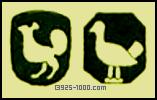   |
Ilmenau City Mark
Thuringia
Mark depicts a cockerel.
|
   |
Karlsruhe City Mark
Baden-Württemberg
The diagonal emblazon is sometimes seen across a shield form, rather than the oval illustrated here.
|


    
|
Kassel City Mark
Hesse
The shield form evolved into a circle in the latter eighteenth century and a letter (indicating assayer) was added below. The fourth example was used after c.1850.
|
     |
Kiel City Mark
Schleswig-Holstein
Stylized nettle leaf, similar marks were used by a number of other cities also located within the Schleswig-Holstein region.
|
     |
Königsberg City Mark
Prussia
Illustrated are19th century examples, earlier versions lacked the standard (loth) number. Koenigsberg is now the Kaliningrad Oblast of the Russian Federation, located between Poland and Lithuania.
|
   |
Leipzig City Mark
Saxony
Variations on the crossed swords and L were used from the early 18th century through the late 19th century.
|
     |
Liegnitz City Mark
Prussia
Variations on the crossed keys were used 16th century through 18th century. Now Legnica in Poland
|
   |
Lubeck City Mark
Schleswig-Holstein
Variations on the double headed eagle were used from ca.1500 through the 18th century.
|
 |
Lüneburg City Mark
Lower Saxony
The crescent moon used from the early 19th century, previously a lion rampant mark had been used. The letter E is an assay master's mark.
|
     |
Magdeburg City Mark
Saxony-Anhalt
Variations the "St. Catherine between towers" mark were used from the 16th and into the 19th century.
|
   
 |
Mainz City Mark
Rhineland-Palatinate
Variations on this wheel symbol were used from the 16th through late 19th century. Usually without the crown at the top. The city of Mulhouse also used a wheel, however it is a gear wheel with toothed edges.
|
 |
Münden City Mark
Hannover
19th century example.
|
